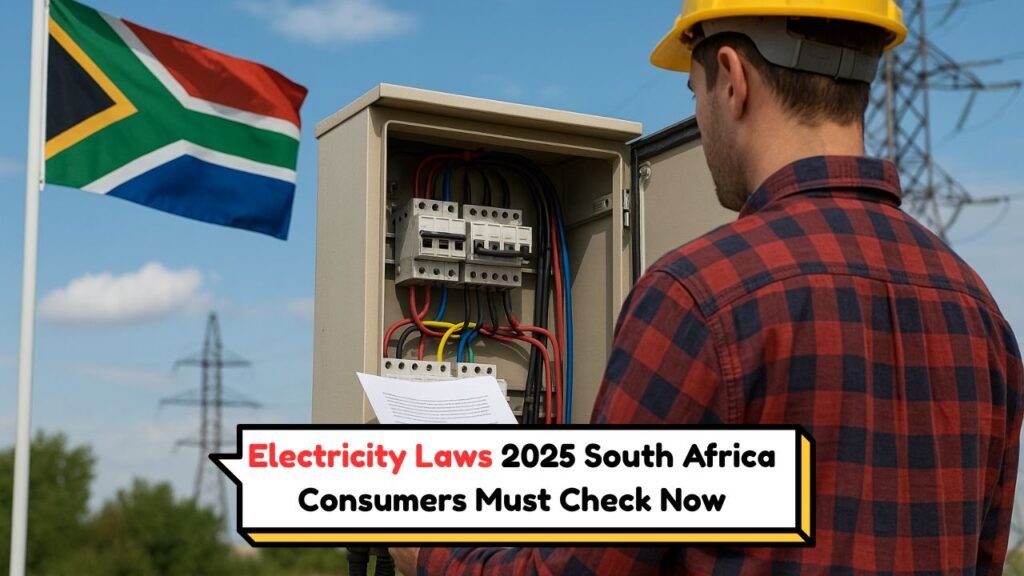2025 Electricity Law Changes South Africa: As South Africa gears up for significant reforms in its electricity sector, the 2025 electricity law changes are poised to reshape the landscape for consumers across the nation. With the country’s energy infrastructure undergoing pivotal transformations, these legislative adjustments are expected to have far-reaching implications on everything from pricing models to the integration of renewable energy sources. The new regulations aim to address the longstanding challenges of load-shedding and outdated infrastructure while also paving the way for a more sustainable and efficient energy future. By understanding the nuances of these changes, South African consumers can better prepare for the impending shifts in how they consume and pay for electricity.

Understanding Key Elements of South Africa’s 2025 Electricity Law
The upcoming 2025 electricity law changes in South Africa are set to introduce a series of critical elements that will impact both the supply and demand sides of the energy market. One of the primary features of the new law is the liberalization of the electricity market, allowing for increased competition among energy providers. This move is expected to drive innovation and efficiency, ultimately benefiting the end consumer through potentially lower costs and improved service quality. Additionally, the law places a significant emphasis on the integration of renewable energy sources, with mandates for utilities to incorporate a higher percentage of solar, wind, and other sustainable energy options into their portfolios.
These changes are designed to not only enhance energy security but also to support South Africa’s commitment to reducing carbon emissions in line with international climate agreements. Another vital aspect of the legislation is the introduction of a more dynamic pricing model, which aims to reflect real-time supply and demand conditions more accurately. This model encourages consumers to adjust their energy usage habits during peak demand periods, further alleviating the strain on the national grid. Moreover, the law prioritizes the modernization of the national grid infrastructure, ensuring that it can accommodate the increased influx of renewable energy and more sophisticated energy management systems.
Impact of 2025 Electricity Law Changes on South African Consumers
For South African consumers, the 2025 electricity law changes bring both challenges and opportunities. One of the most direct impacts will be seen in electricity tariffs, which may fluctuate more frequently due to the adoption of the dynamic pricing model. While this may initially seem daunting, it also empowers consumers with more control over their energy bills by encouraging them to shift consumption to off-peak times when rates are lower. Additionally, with the increased competition among energy suppliers, consumers are likely to benefit from better service offerings and potentially more competitive pricing.
Furthermore, the emphasis on renewable energy integration means that consumers will have greater access to cleaner energy sources. This shift not only contributes to environmental sustainability but also provides homeowners with the opportunity to invest in personal renewable energy solutions, such as solar panels, which can further reduce dependency on the national grid and lower electricity costs in the long term. The law also introduces measures to protect vulnerable consumers, ensuring that the transition does not disproportionately affect low-income households. By providing subsidies and support for energy-efficient appliances, the government aims to assist these consumers in adapting to the new energy landscape.
Renewable Energy and Its Role in the 2025 Electricity Law
The 2025 electricity law places a significant focus on the role of renewable energy in South Africa’s future. As the country looks to diversify its energy sources and reduce reliance on coal, the integration of renewables is a key component of this legislative overhaul. This shift is expected to drastically transform the energy mix, with a concerted effort to increase the share of renewables in the national grid. Solar and wind power are at the forefront of this transition, with the government setting ambitious targets for their integration by 2025.
For consumers, this means an expanded array of options when it comes to sourcing their electricity. The law encourages the development of microgrids and community-based renewable energy projects, which can provide localized, reliable power solutions, particularly in rural and underserved areas. Moreover, the legislation incentivizes investments in renewable energy technologies, offering tax breaks and grants to both individuals and businesses looking to go green. This proactive approach not only supports the growth of the renewable energy sector but also aligns with global trends towards sustainable energy practices.
Challenges and Opportunities Arising from the 2025 Electricity Law
While the 2025 electricity law changes present numerous opportunities for South African consumers, they also come with their own set of challenges. One of the primary concerns is the initial cost of transitioning to renewable energy and upgrading infrastructure to meet the new standards. Although the government provides incentives, the upfront investment required may be prohibitive for some consumers. Additionally, the complexity of navigating dynamic pricing models may pose a learning curve for many, necessitating educational initiatives to help consumers optimize their energy usage effectively.
Despite these challenges, the opportunities presented by the law are substantial. Consumers stand to gain from a more reliable and resilient power supply, reduced environmental impact, and potential cost savings in the long run. Furthermore, the shift towards a more competitive market landscape could spur innovation and lead to the development of cutting-edge energy solutions tailored to the specific needs of South African consumers. As the country embraces these changes, it sets a precedent for other nations grappling with similar energy challenges, showcasing how policy reform can drive progress towards a sustainable energy future.



